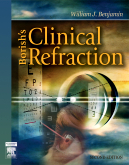|
|
|
| |
 |
|
|

|
 推薦指數:
推薦指數:





|
|
- 內容介紹
|
Borish's Clinical Refraction, 2nd Edition
By William J. Benjamin, OD, MS, PhD
Approx. 1712 pages Approx. 1000 illustrations (550 in full color)
Trim size 8 1/2 X 10 7/8 in
Copyright 2006
Description
Now updated and expanded to cover the latest technologies, this full-color text on clinical refraction uses an easy-to-read format to give optometry students and practitioners all the important information they need. Also covers a wide range of other aspects of the eye exam, including anterior and posterior segment evaluations, contact lens, ocular pharmacology, and visual field analysis. Four new chapters cover wavefront-guided refraction, optical correction with refractive surgeries, prosthetic devices, and patients with ocular pathology.
Key Features
Offer precise, step-by-step how-to's for performing all of the most effective refractive techniques.
Presents individualized refractive approaches for the full range of patients, including special patient populations.
Contriubtors are internationally recognized, leading authorities in the field.
New to this Edition
New full-color design with full-color images throughout.
Completely updated and expanded to include current technologies.
A new chapter on Optical Correction with Refractive Surgeries, including keratoplasty, traditional refractive surgeries (e.g. LASIK and PRK), crystalline lens extraction with and without pseudophakia, the new presbyopic surgery, etc.
A new chapter on Wavefront Guided Refraction provides information on the advantages and limitations the Hartmann-Shack Method for objective refraction plus aberrometry and the refraction and the use of in the correction of the eye with spectacles, contact lenses, and refractive surgery.
A new chapter on Patients with Ocular Pathology reflects the most current knowledge of patients with ocular pathologies.
Provides information on Optical Correction with Prosthetic Devices, including corneal onlays, stromal implants, phakic intraocular lenses, etc.
Includes new chapters and/or discussions on such topics as: Aberrations of the Eye, Refractive Consequences of Eye Pathology, Diagnosis and Treatment of Dry Eye, Diagnosis of Pathology of the Anterior Segment, Diagnosis of Glaucoma, and Diagnosis of Pathology of the Posterior Segment.
Visual Acuity chapter expanded to include the effect of refractive error on visual acuity and statistics on how much of a change in visual acuity is significant.
Objective Refraction, Corneal Topography, and Visual Field Analysis chapters include the addition of new electro-optical and computer techniques and equipment.
Chapters on Multifocal Spectacle Lenses and Contact Lenses now cover newer progressive addition lenses and contact lenses that are now on the market.
Electrodiagnosis chapter revised to take a more clinical approach.
Table of Contents
SECTION I: PRINCIPLES
1. Refractive Status of the Eye
2. Incidence and Distribution of Refractive Anomalies
3. Development of the Ametropias
4. Accommodation, the Pupil, and Presbyopia
5. Fusion and Binocularity
SECTION II: ADJUNCT EXAMINATIONS
6. The Ophthalmic Case Historian
7. Visual Acuity
8. Contrast Sensitivity and Glare Testing
9. Color Vision
10. Ocular Motility
11. The Physical Examination
12. Pharmacology and Refraction
13. Anterior Segment Evaluation
14. Posterior Segment Evaluation
15. Visual Field Screening and Analysis
16. Clinical Electrophysiology
SECTION III: THE REFRACTION
17. Corneal Topography
18. Objective Refraction: Retinoscopy, Autorefraction and Photorefraction
19. Wavefront-Guided Refraction
20. Monocular and Binocular
21. Phorometry and Stereopsis
SECTION IV: ANALYSIS AND PRESCRIPTION OF OPTICAL CORRECTIONS
22. Analysis, Interpretation, and Prescription for the Ametropias and Heterophorias
23. Correction with Single Vision
24. Correction with Multifocal Spectacle Lenses
25. Prescription of Absorptive Lenses
26. Applied Optics of Contact Lens Correction
27. Clinical Optics of Contact Lens Prescription
28. Correction of Presbyopia with Contact Lenses
29. Optical Correction with Refractive Surgeries and Prosthetic Devices
SECTION V: SPECIAL CONDITIONS
30. Infants, Toddlers, and Children
31. Patients with Amblyopia and Strabismus
32. Patients with Anisometropia and Aniseikonia
33. Patients with High Refractive Error
34. Patients with Irregular Corneal Astigmatism
35. The Elderly
36. Patients with Low Vision
37. Patients with Ocular Pathology
|
|
|

